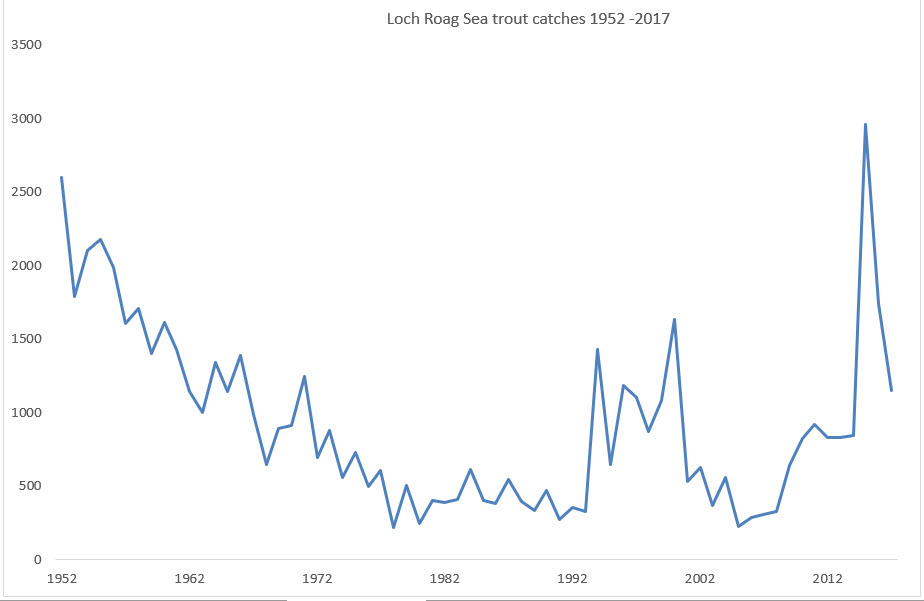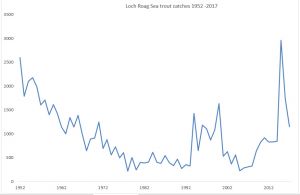Fishy pseudo-science: Corin Smith, ‘Economic Adviser’ to an as yet unknown senior politician, wrote on his Facebook page that ‘The cynical manipulation of data is used to sow doubt and confuse and frighten politicians.’ Mr Smith was making reference to one of the graphs we included in a recent reLAKSation mailing. Notwithstanding that Mr Smith misinterpreted the purpose of the graph even though an explanation was provided, we will include further graphs in this week’s reLAKSation. These will be produced from new data which became available this week.
The data is the latest government figures for catches of wild migratory fish caught by rod and line from rivers across the whole of Scotland (http://www.gov.scot/Publications/2018/04/2149). This latest catch data was reported by the Times newspaper as the fourth lowest on record, which has promoted calls for action to save one of the country’s most lucrative tourist industries. The newspaper spoke to Andrew Graham Stewart of Salmon & Trout Conservation Scotland (S&TCS) who welcomed the Scottish Government’s conservation measures but said that he hoped ministers would go further with new regulations to tackle the damaging effect of fish farms. He added that these farms release millions of sea lice that prey on juvenile wild salmon. Mr Graham Stewart’s comments would likely lead Times readers to conclude that salmon farming was the reason why wild salmon catches are so low. In fact, salmon numbers are down across all of Scotland including catches from rivers on Scotland’s east coast where there are no salmon farms at all.
We, at Callander McDowell, would like to go one step further and suggest that salmon farming is not even the main reason why wild fish stocks are in decline along the west coast and that S&TCS are simply using the salmon farming as a scapegoat for the wide range of problems affecting the wild fish sector. We are sure that we will be accused again of a cynical manipulation of data to frighten and sow doubt and confusion amongst politicians, but to counter any such claims we will do as told at school and show how our calculation was worked out. We would also be happy to discuss the whole issue with the wild fish sector, but they appear extremely reluctant to do so.
Mr Graham Stewart says that the Scottish Government needs to implement new regulations to tackle the damaging effects of salmon farming. Yet, he doesn’t attempt to quantify what damaging effect salmon farming has on wild fish numbers. It is all very reliant on vague generalisations such as those in the Times that seemingly link the decline in wild fish catches to salmon farming but without any direct supporting evidence.
Salmon & Trout Conservation Scotland have attempted to bring some scientific evidence to the debate. They commissioned a report from the Norwegian Institute of Nature Research (NINA), a link to which can be found on the S&TCS website (https://www.salmon-trout.org/wp-content/uploads/2018/01/Thorstad-Finstad-2018-Impacts-of-salmon-lice-NINA-Report-1449-2.pdf).
The abstract/executive summary of this report includes the following paragraph:
Studies indicate an annual loss of 50 000 adult wild Atlantic salmon to Norwegian rivers because of salmon lice, which corresponds to an overall loss of 10% of the wild salmon because of salmon lice on a national level (i.e., including both farm-free and farm-intensive areas, based on data from the years 2010-2014). Salmon lice from fish farms are identified as one of the two largest threats to wild salmon in Norway.
The report effectively states that the impact of sea lice from salmon farms equates to the death of 50,000 adult wild salmon. The figure is derived in part from mathematical model built using data collected by sampling.
What is known is that Norway produces about 1.2 million tonnes of salmon a year. Production does vary from year to year, but the sea lice research detailed in the S&TCS report is derived from data collected over four years. It would be fair to say that 1.2 million tonnes of farmed salmon production resulted in the equivalent of 50,000 salmon deaths a year due to sea lice. This equates to one fish death for every 24 tonnes of production (1.2 million tonnes divided by 50,000 fish).
The question is whether the same mortality rate can be applied to Scotland. Experimental smolt release research in Ireland and Norway found results were similar in both countries. Marine Scotland Science were unsure whether Scotland would be the same so instigated a £600,000 three-year research programme in which they conducted similar research. This work has now finished, and MSS have written a final report. So far, they have remained strangely quiet about what they found, even though the results would have major relevance to the Scottish Parliamentary enquiry.
Without their new data, we can only conclude that what happens in Scotland will not be so different from what happens in both Ireland and Norway and therefore one death for every 24 tonnes of production is valid.
Currently, Scotland produces about 170,000 tonnes of farmed salmon. A simple calculation dividing total tonnage by 24 results in a figure of 7,083. This is the equivalent number of fish, derived from the Norwegian model, that die in Scotland as a result of sea lice emanating from salmon farms.
Just to be clear, according to data commissioned by the S&TCS from Norway, the impact of salmon farming on wild fish is the death of 7,083 fish per year. Now, we at Callander McDowell, have major issues with the Norwegian work and we would argue that this figure is an over-estimate because of some preconceptions built into the mathematical model. However, for the basis of this specific discussion, we will accept this figure of 7,083 for now.
The next data we will use in this analysis is the Scottish Government catch data that was published this week. The reports accompanying the data describe the overall situation across Scotland. In total, anglers have caught 75,513 wild migratory fish in 2017 of which 66,997 were returned. However, the remaining 8,516 wild fish were caught and killed by anglers.
To put this in perspective, data from S&TCS and the Scottish Government shows that salmon farms are supposedly responsible for the deaths of 7,083 wild fish whilst anglers have killed a total of 8,516. Whilst, mortality due to salmon farming has not exceeded this figure of 7,000 fish because production has yet to pass 170,000 tonnes, anglers have killed hundreds of thousands of wild fish over the past decades. It is only the continued decline of wild fish that has forced anglers to start to return the fish they catch and yet, as we have seen from the recent ECCLR Committee discussion about the new salmon regulations, there is still a great deal of opposition to releasing fish rather than killing them.
As we reflect on these figures, we do wonder why the Scottish Parliament is focusing its attention on salmon farming, when surely recreational angling is also in greater need of its attention, including in relation to its economic impact. The Times reports that angling is thought to generate about £100 million (although this figure is from several years ago) and supports about 3,000 jobs. The paper highlights that salmon fishing on the Tweed is worth £24 million and supports 500 jobs. This means that if the Tweed is excluded, angling in the rest of Scotland is worth £76 million and 2,500 jobs. Of course, what the paper fails to mention is many of these jobs are seasonal, low paid jobs.
The Norwegian study suggests that the 50,000 salmon deaths due to salmon farming equates to around 10% of the wild salmon population. Fisheries Management Scotland (FMS) suggested to the REC Committee that mortality was more likely to be 20% but this figure comes from an interpretation of the Norwegian and Irish experimental smolt release study that used real fish not some mathematical model. The findings of this work put the mortality of wild fish due to salmon farming at just 1%. This would mean that the total mortality of wild fish in Scotland due to salmon farming would be around 708 fish per year. By comparison, anglers on just the River Tay where Mr Smith fishes, killed 662 wild fish.
Sophisticated data: In yet another Facebook posting, Mr Corin Smith says there should be a debate about whether there is a place in Scotland for salmon farming. He says that this debate is more relevant as more environmental information becomes available. He writes that ‘For years we have had to form hypothesis from weak, issue ridden data sets like historic catch returns. Thankfully, those days are consigned to the past and we can all move passed (sic) catch returns to a more sophisticated view of the world’.
Mr Smith doesn’t appear to like catch data solely because we, at Callander McDowell have used it to demonstrate that salmon farming does not have the impact that the wild fish lobby claim. We suspect that his sophisticated view of the world is that which favours sports angling and is critical of salmon farming.
If Mr Smith wants a debate about the salmon farming industry, then let’s begin with a debate about the evidence from catch returns. Although we have been working on the subject for over three years, there has yet to be any meaningful debate about the findings. This is simply because, they do not support the claims made by the angling lobby about the industry and hence they refuse to engage in this debate.
Meanwhile, the wild fish debate rumbles on. Whilst Mr Smith believes that catch data is just history, not all his colleagues from the wild fish sector share his view. Sir Peter Creswell of the Uig and Hamanavay Estate in the Outer Hebrides has submitted evidence to the REC Committee saying that catch data from the local estates proves that salmon farming is having a negative impact on sea trout numbers (http://www.parliament.scot/S5_Rural/Uig_and_Hamanavay_Estate_(UHE).pdf).
His submission includes a comparison of sea trout catches from the Haamanavay Estate, which Sir Peter says is free from any salmon farming activity and the Morsgail Estate which he says is. Sir Peter provides catch data for Morsgail from 1880, 1888, 1930 and 1955.
In 1955, the total catch was 526 sea trout. By comparison, the sea trout catch fro the last four years has been 83, 388. 62 and 25. Sir Peter says that these low catches are due to the presence of salmon farms.
In contrast, Sir Peter says that the Hamanavay catches of sea trout and finnock for the same four years are 1233, 1091, 873 and 723 and these higher catches are due to the absence of salmon farms. Sir Peter recorded sea trout and finnock separately but if they are added together, then over the last four years, catches are clearly in decline, yet as Sir Peter’s message clearly states – there are no salmon farms present.
Just coincidentally, we were recently given a book – The Sporting Estates of the Outer Hebrides Past and Present by David S D Jones. The chapter about the history of Uig and Hamanavay Estate ends by listing the bag catch for 2006 The property yielded 84 grouse, 30 Snipe, 22 Woodcock, 6 Golden Plover, 15 geese, 27 stags, 28 hinds, 68 salmon and grilse, 122 sea trout and 775 brown trout.
Unfortunately, we are unable to look at specific catches for the estate as the government catch data is recorded in terms of the local fishery district not the individual estates on the Isle of Lewis. The geographic area that includes the area Sir Peter refers to is covered by two fishery districts – Loch Roag and Resort. For direct comparison, it would have been useful if one of the estates had been in one fishery district and the other in the second, but nothing is so simple. Marine Scotland Science inform me that the Hamanavay data is included in the Loch Roag fishery district whilst rather confusingly, some of the Morgsail catches are also recorded in Loch Roag with others included in the Resort fishery district catch.
It is worth looking at the catches from these fishery districts, whether impacted by salmon farms or not. We have included the data from 1952 to 1982 in one graph and from 1982 to present in another. 1982 was the first year the salmon farming industry officially recorded its output, which at the time totalled just 1,000 tonnes for all of Scotland.
The two graphs of the sea trout catch clearly show that before salmon farming became established sea trout catches from the Loch Roag fishery district were in decline. Interestingly, the graph from 1982 onwards shows the reverse with catches actually increasing, despite all that the angling lobby claim otherwise.
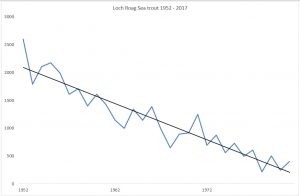
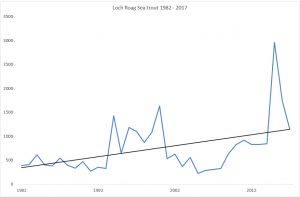
The full series can be seen in the following graph.
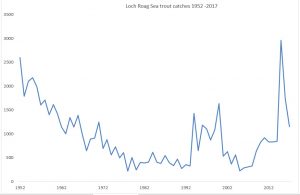
We have also included the graphs for salmon and grilse catches for Loch Roag.
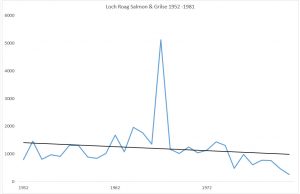
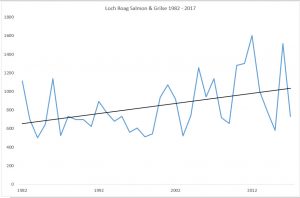
The whole of the time series is in the following graph:
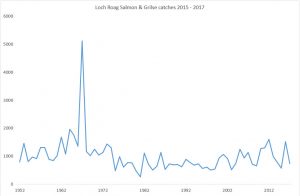
Although some of the Morsgail Estate catches are recorded within the data for the Resort Fishery District, the actual data is rather thin on the ground. According to MSS data, catches of sea trout have only been recorded for just four of the sixty-five years data has been collected. It is unclear whether this is because the district has not been fished or whether any catches haven’t been recorded. Another possibility is that finnock under 2lbs in weight have been returned without any record. Apparently, this was common practice and has been cited as one of the reasons why catch data is unreliable. It’s funny how the salmon industry is expected to keep and share accurate records whilst the angling sector is not.
The catch data does show that the impacts on wild fish from salmon farming are not as great as the angling lobby claim. However, it seems that the angling lobby hope that if they ignore this data for long enough, it will be forgotten. They will have a long wait.
Seal of approval: Fishupdate.com reports from Canada that the number of seals on the edge of the Gulf of St Lawrence has risen so rapidly in recent years that it has led to calls for an increased seal hunt to protect fish stock. Seal numbers have risen for 5,000 in 1965 to over 100,000 today. Those in favour of some form of control argue that unless top predators are kept in check then ‘something is going to go out of whack’. Opposition to these proposals is expected from the environmental sector.
Of course, this is not a simple question especially when the predator and the prey are both protected, as in the case of salmon. Scotland faces similar problems to Canada as the number of seals on the west coast have increased significantly. Its not surprising that wild fish numbers have declined by so many.
The writing has been on the wall. In the book Loch Maree’s Missing Sea Trout, a report cited from Trout & Salmon magazine in October 1987 highlighted ‘the presence of two seals in the vicinity of the islands (in Loch Maree) wasn’t helping either’.
The December 1987 issue of the magazine continued the theme in its Scottish column: ‘Despite being a known fact that seals are multiplying at the rate of four percent per annum, the Scottish Animal Rights Group has warned of fresh protests if a new grey seal cull goes ahead. The group have told the Scottish Secretary that they reject the Salmon Fishery Board’s and Scottish fishermen’s argument for a re-opening of the Scottish grey seal cull and the right to shoot seals around fishery stations’.
‘It has been noted in this column more than once that the increase in the seal population has been dramatic in the vital firths which are used for returning salmon. Some are simply ‘black’ with these animals. Twenty years ago, it was a bit of an event to point out to one’s children that there was a couple of seals lying on a sandbank. Now these same sandbanks are alive with them’.
‘Anglers are not anti-conservationists, but they favour keeping seal numbers within a reasonable proportion and therefore have made these views known to the authorities’.
‘Look what seals have done to the famous sea trout fishery Loch Maree this past year’.
It is worth remembering that these comments were made before anglers had salmon farms to use as a scapegoat.
The book Loch Maree’s Missing Sea Trout by Martin Jaffa can be bought from Amazon.co.uk https://www.amazon.co.uk/Loch-Marees-Missing-Sea-Trout/dp/199997140X/ref=sr_1_1?ie=UTF8&qid=1524894161&sr=8-1&keywords=loch+marees+missing+sea+trout
Or Amazon.com

